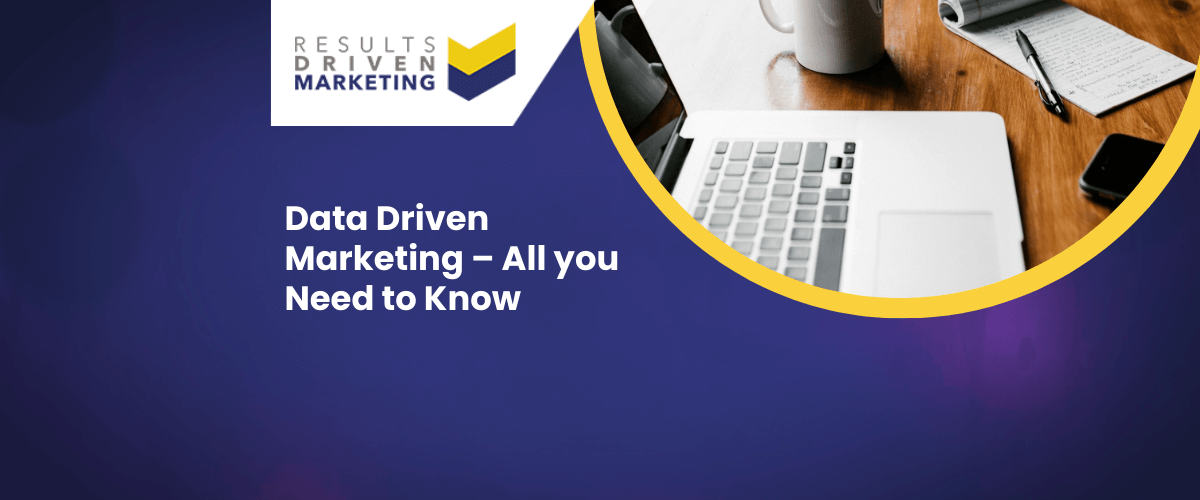
Data Driven Marketing – All you need to know
Data-driven marketing is a powerful tool in today’s world of digital marketing.
It involves using data analysis to gather insights into customer behaviour and preferences, allowing marketers to create personalised and targeted marketing campaigns.
This article will delve into the benefits of data-driven marketing and provide tips on how businesses can effectively leverage data to improve their marketing strategies.
What is data-driven marketing and why is it important?
Data-driven marketing has become a buzzword among marketers over the last few years.
It is a term used to describe the use of data to inform marketing strategy and decision-making processes.
In simple words, it is a data-based marketing approach that enables marketers to identify who their customer is, how their customer behaves, and what their customer wants.
The importance of data-driven marketing cannot be overstated.
Traditionally, marketing strategies were developed based on assumptions, and marketers had to rely on a trial-and-error approach to see what worked and what didn’t.
However, with the advent of technology and the abundance of data available today, marketers have the ability to make data-driven decisions.
Data-driven marketing helps businesses to get a better understanding of their customers.
Through analytics, businesses can identify patterns in customer behaviour and use these insights to develop targeted marketing campaigns.
This leads to more efficient use of marketing resources, better ROI, and a higher probability of converting leads into customers.
Data-driven marketing also enables businesses to optimise their marketing efforts.
By measuring the success of marketing campaigns, businesses can identify what works and what does not.
This means that they can adjust their strategy for maximum impact, leading to better conversion rates and more satisfied customers.
In conclusion, data-driven marketing is a powerful tool that can help businesses make informed decisions and achieve their marketing objectives.
By utilising customer data, businesses can create targeted marketing campaigns, optimise their marketing efforts, and ultimately deliver better results.
Given the abundance of data available today, data-driven marketing is no longer a luxury but a necessity for all businesses that want to stay competitive in the market.
Sources of data for marketing (e.g. customer relationship management (CRM), social media, website analytics)
As marketers, we all know that data is critical to make well-informed decisions.
In today’s digital age, data is abundant, and it comes in various forms.
Customer Relationship Management (CRM), social media, and website analytics are some of the primary sources of data for marketing.
In this part of the article, we will explore each of these data sources in detail and how they can be used to drive business growth.
1. Customer Relationship Management (CRM)
A CRM system is an essential tool for businesses to manage their interactions with customers and prospects.
It records customers’ details, such as their contact information and purchase history, which can provide critical insights for marketers.
With a CRM system, businesses can identify trends, patterns, and behaviours that help them tailor their messaging and offerings to individual customers.
The data from a CRM system can be used to segment customers based on their preferences, buying behaviours, and interests.
Marketers can also use this data to refine their messaging and deliver targeted promotions and offers to specific segments of customers.
This allows businesses to improve their customer engagement and maximise the return on investment (ROI) of their marketing efforts.
2. Social Media
Social media platforms offer a wealth of data for marketers.
Facebook, Twitter, LinkedIn, and other platforms provide insights about the audience demographics, engagement rates, and post performance.
With social media analytics tools, businesses can track mentions of their brand, measure the success of their campaigns, and identify influencers who can help them expand their reach.
Social media data can also be used to create authentic, personalised experiences for customers.
Brands can leverage social listening to monitor conversations about their products and services and respond promptly to customer inquiries and complaints.
This can help businesses build trust with their customers and enhance their brand reputation.
3. Website Analytics
Website analytics tools, such as Google Analytics, allow businesses to track visitors to their site, measure engagement, and gain insights into customer behaviours.
Marketers can use this data to understand the performance of the different pages on their site and optimise their content and design to improve user experience.
Website analytics data can also be used to track the success of marketing campaigns.
By setting up conversion tracking, businesses can measure the number of visitors who fill out a contact form, make a purchase, or sign up for a newsletter.
This information is valuable for marketers to understand the ROI of their campaigns and make data-driven decisions on future marketing strategies.
In conclusion, the data from CRM systems, social media, and website analytics help marketers gain insights into their customers and make informed decisions on their marketing strategies.
By using these data sources, businesses can improve customer engagement, deliver targeted promotions, and track the success of their marketing campaigns.
In today’s digital age, harnessing the power of data is critical for businesses to remain competitive and to drive business growth.
The role of predictive analytics in data-driven marketing
Data-driven marketing has become increasingly popular in recent years as companies realise the importance of making decisions based on facts and insights rather than guesswork.
One key tool that has been crucial to this shift is predictive analytics.
Predictive analytics can be defined as the use of data, statistical algorithms, and machine learning techniques to identify the likelihood of future outcomes based on historical data.
Essentially, it helps to predict what is likely to happen in the future based on what has happened in the past.
In the world of data-driven marketing, predictive analytics can be used in a variety of ways to help companies make better decisions. Here are just a few examples:
1. Targeted Advertising:
By analysing data on customer behaviour and preferences, companies can use predictive analytics to determine which customers are most likely to be interested in specific products or services.
This allows them to target their advertising efforts more effectively, getting the right message in front of the right people at the right time.
2. Customer Retention:
Predictive analytics can also be used to identify which customers are most likely to churn (i.e. stop doing business with the company).
By understanding the factors that contribute to churn, companies can take proactive steps to retain those customers, such as offering targeted promotions or improving customer service.
3. Product Development:
Predictive analytics can even be used to inform product development decisions.
By analysing customer feedback and purchasing data, companies can get a better understanding of what features or improvements would be most valuable to their target audience.
Of course, none of this would be possible without data.
In order for predictive analytics to work, companies need to have access to large amounts of high-quality data.
This is one reason why data collection and management has become such a critical part of modern marketing.
Overall, the role of predictive analytics in data-driven marketing cannot be overstated.
By helping companies make more informed decisions, it can lead to more effective marketing campaigns, higher customer satisfaction, and ultimately, increased revenue.
As the amount of data available continues to grow, the importance of predictive analytics is only likely to increase.
Segmenting and targeting audiences based on data insights
In today’s digital age, collecting data from various sources has become a common practice for businesses across industries.
With the rise of analytics tools, it’s easier than ever to gather information about your customers, their behaviours, preferences, and interests.
Segmenting and targeting audiences based on these data insights is a smart strategy for any marketer looking to maximise the effectiveness of their campaigns.
By dividing your audience into smaller groups based on similarities among them, you can create more personalised messages that resonate with each group.
Here are some key steps to take when segmenting and targeting audiences based on data insights:
1. Gather Data:
Start by collecting as much data as possible on your customers.
This includes demographic information, website behaviour, purchase history, social media interactions, and more.
Use analytics tools like Google Analytics, CRM tools and other marketing automating tools to collect customer data.
2. Identify Commonalities:
Analyse your data to identify commonalities and trends among different groups of customers.
For example, customers who have purchased a certain product in the past may be more likely to purchase a similar product in the future.
3. Define Customer Segments:
Once you’ve identified commonalities, create customer segments based on those similarities.
This could be based on demographics, behaviours, interests, or other criteria that make sense for your business.
4. Develop Targeted Messages:
Utilise the insights from each segment to create targeted messages that will resonate with each group.
For example, you may want to target one segment with messaging that emphasises the high quality of your products, while another segment may respond better to messaging that highlights your company’s values or social impact.
5. Test and Refine:
Continuously test your messaging and refine it based on how different customer segments respond.
This will help you improve the effectiveness of your campaigns over time and maximise your ROI.
In conclusion, segmenting and targeting audiences based on data insights is a critical strategy for modern marketers.
By gathering data, identifying commonalities, defining customer segments, developing targeted messages, and continuously testing and refining, you can ensure that your marketing efforts are more effective and efficient in reaching your ideal audience.
Personalisation and customisation in marketing with data
In today’s marketing landscape, personalisation and customisation have become key tactics in reaching consumers effectively.
By leveraging data, businesses can craft targeted, personalised messages that resonate with their target audience, leading to increased engagement and loyalty.
Personalisation refers to tailoring content and messaging to specific individuals, based on their demographics, behaviours, and preferences.
This can involve using customer data to create targeted ads, personalised product recommendations, and relevant content.
Customisation, on the other hand, lets consumers create their own personalised experiences.
This includes offering a range of options, such as different product features, colours, sizes, or flavours, which allow consumers to customise their purchases to meet their specific needs and preferences.
Data plays a critical role in enabling both personalisation and customisation in marketing.
By collecting and analysing customer data, businesses can gain insights into their audience’s preferences, behaviours, and purchasing patterns.
This allows them to create targeted marketing campaigns that resonate with specific segments of their audience.
Businesses can use a variety of methods to collect customer data, including social media analytics, website tracking, and customer feedback surveys.
With this data in hand, businesses can segment their audience into different groups based on factors like age, location, and interests, and develop personalised marketing campaigns tailored to each group.
For example, a clothing retailer might create targeted email campaigns featuring personalised recommendations based on a customer’s purchase history or website browsing behaviour.
Customisation can also be achieved by leveraging customer data.
By giving consumers choices and options in their purchasing journey, businesses can allow them to create their own personalised experiences.
For example, a car manufacturer might offer different configurations and add-ons for their vehicles, allowing consumers to create a personalised product that meets their specific needs.
Personalisation and customisation have become increasingly critical tactics in effective marketing.
By leveraging customer data, businesses can craft targeted marketing campaigns that resonate with their audience, leading to increased engagement, loyalty, and sales.
As businesses continue to evolve their marketing strategies, personalisation and customisation are sure to remain essential components of any successful campaign.
Implementing data-driven marketing strategies (e.g. AB testing, multichannel campaigns)
In today’s fast-paced digital world, marketing strategies cannot be based on guesswork.
It is essential to base decisions on data to ensure that campaigns are optimised and effective.
Data-driven marketing strategies rely on collecting, analysing, and using data to make informed decisions about marketing initiatives.
Among the most effective data-driven marketing strategies are AB testing and multichannel campaigns.
AB testing is a technique that compares two versions of a marketing message or campaign to determine which one performs better.
For example, an email marketing campaign could have two versions of the email with different subject lines or calls to action.
By sending each version to a sample of the target audience, the marketer can determine which one is more effective in terms of click-through rates or conversions.
Multichannel campaigns are another vital aspect of data-driven marketing strategies.
In today’s world, customers interact with brands across multiple channels, including social media, email, websites, and mobile apps.
A multichannel campaign seeks to reach customers on all these channels, ensuring that messaging is consistent and optimised for each platform.
Data analysis can be used to identify the most effective channels for each segment of the target audience and tailor messaging accordingly.
Implementing data-driven marketing strategies requires a strong foundation of data collection and analysis.
A robust customer relationship management (CRM) system can collect data on customer interactions with a brand, including website visits, email opens, social media engagement, and purchases.
This data can then be analysed to identify patterns and trends, which can inform marketing decisions.
Once data is collected, it is crucial to make it actionable.
This involves using data analysis tools to create a dashboard of key performance indicators (KPIs) that can be used to measure the effectiveness of marketing campaigns.
These KPIs should be specific, measurable, and align with business goals.
Data-driven marketing strategies are not a one-time initiative.
They require ongoing analysis, optimisation, and testing to ensure that they remain effective.
This involves regularly reviewing KPIs, analysing data, and making data-driven decisions to improve campaigns continually.
In conclusion, implementing data-driven marketing strategies is essential in today’s world to ensure effective campaigns.
AB testing and multichannel campaigns are two particularly compelling aspects of data-driven marketing strategies.
To implement these strategies successfully, an organisation must have a strong foundation of data collection and analysis and a commitment to ongoing optimisation and testing.
With the right tools and approach, organisations can leverage data to create effective campaigns that drive business results.
Measuring the effectiveness of data-driven marketing efforts
Measuring the effectiveness of data-driven marketing efforts is essential for businesses looking to make data-driven decisions and optimise their marketing campaigns.
With the increasing availability of data and the rise of digital marketing, measuring and analysing the performance of your marketing campaigns can provide valuable insights into customer behaviour, preferences, and trends, allowing you to make more informed decisions and improve your bottom line.
One of the most critical aspects of measuring the effectiveness of data-driven marketing efforts is defining and tracking the right metrics.
These metrics can range from website traffic, conversion rates, email open rates, and social media engagement, to more specific metrics such as customer lifetime value and customer acquisition cost.
The key is to identify the key performance indicators (KPIs) that matter most to your business, and track them over time to gauge the effectiveness of your marketing efforts.
Another important aspect of measuring the effectiveness of data-driven marketing is to establish a baseline of performance.
This means setting benchmarks for your KPIs based on historical data or industry standards, and using these benchmarks to track progress and identify areas for improvement.
For example, if your website conversion rate is currently 2%, you may set a goal to increase it to 5% over the next six months.
Once you have established your KPIs and baseline metrics, it is essential to regularly analyse your data and identify patterns and trends.
This can involve using data visualisation tools or data analysis software to create visual representations of your data, allowing you to quickly and easily identify areas for improvement or new marketing opportunities.
This analysis should be conducted on an ongoing basis, as trends and customer behaviour can change rapidly in today’s digital marketplace.
Finally, measuring the effectiveness of data-driven marketing efforts requires a data-driven mindset.
This means being willing to experiment and try new approaches, as well as being open to feedback and input from customers and stakeholders.
It also means being willing to adapt and adjust your marketing strategies based on the data and insights you gain from your analysis.
In conclusion, measuring the effectiveness of data-driven marketing efforts is critical for businesses looking to stay ahead of the competition and achieve long-term success.
By defining and tracking the right metrics, establishing a baseline of performance, regularly analysing your data, and embracing a data-driven mindset, you can make more informed decisions, improve your marketing campaigns, and drive growth and profitability for your business.
Conclusion
In today’s world of digital marketing, data-driven marketing is an essential tool for businesses looking to remain competitive and achieve long-term success.
By collecting and analysing customer data, businesses can gain valuable insights into customer behaviour and preferences, allowing them to create personalised and targeted marketing campaigns.
This article has explored the importance of data-driven marketing and provided tips on how businesses can use sources of data such as CRM, social media, and website analytics to optimise their marketing efforts.
Strategies such as AB testing and multichannel campaigns have also been highlighted, along with the importance of measuring the effectiveness of marketing campaigns by establishing KPIs, baseline metrics, and adopting a data-driven mindset.
By leveraging the power of data-driven marketing, businesses can improve customer engagement, efficiency, ROI, and ultimately achieve their marketing objectives.





